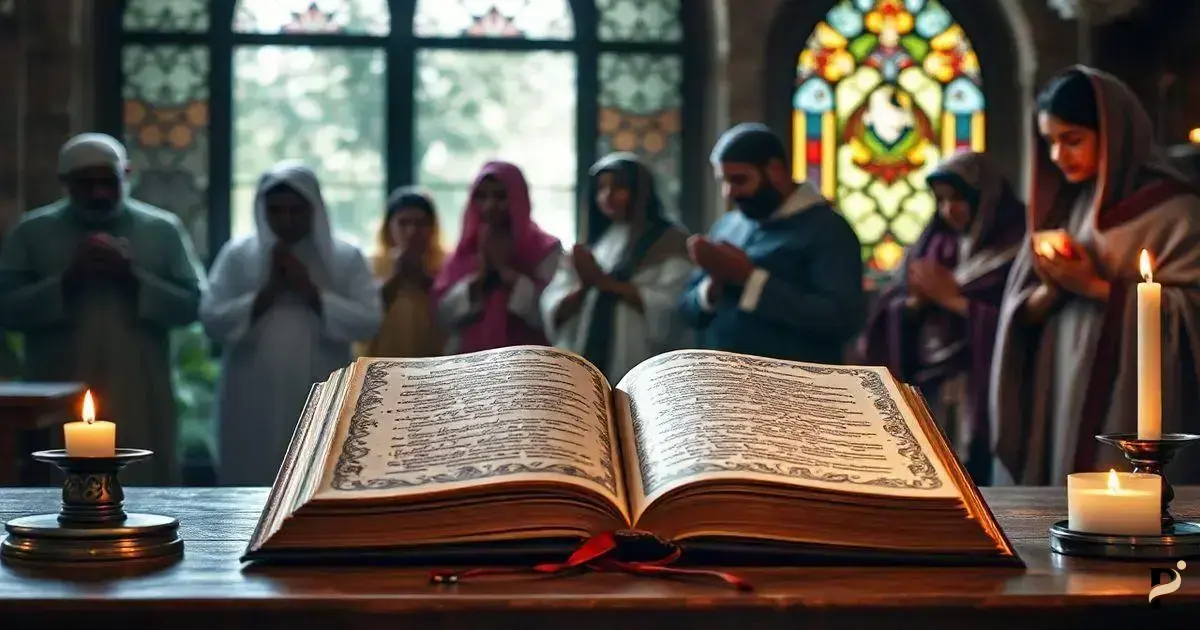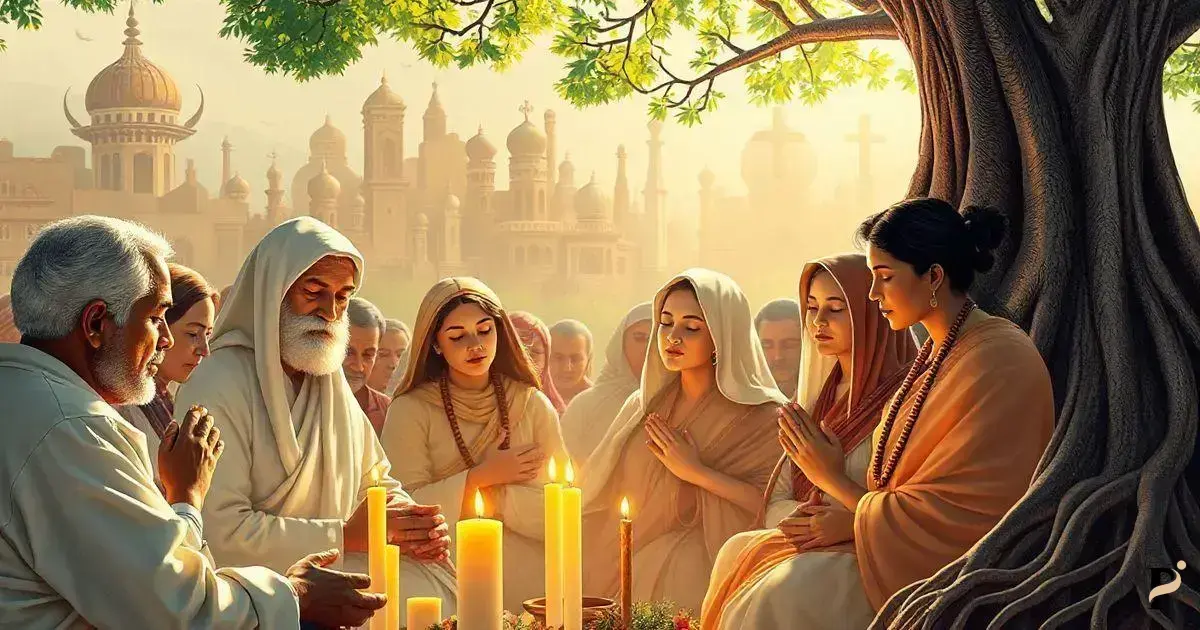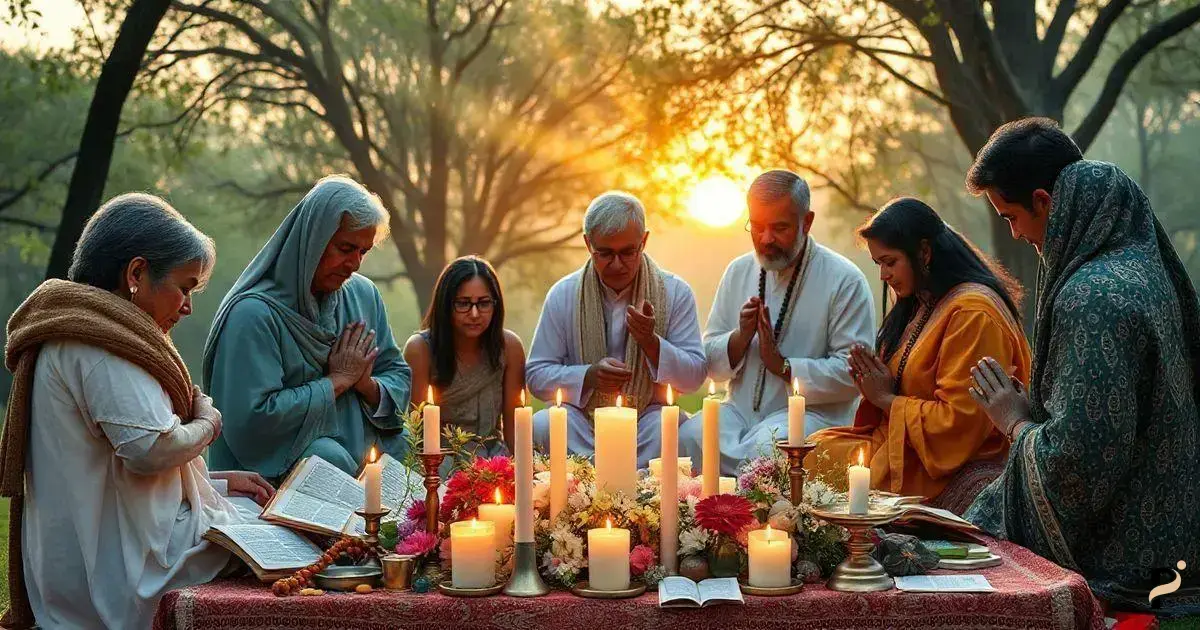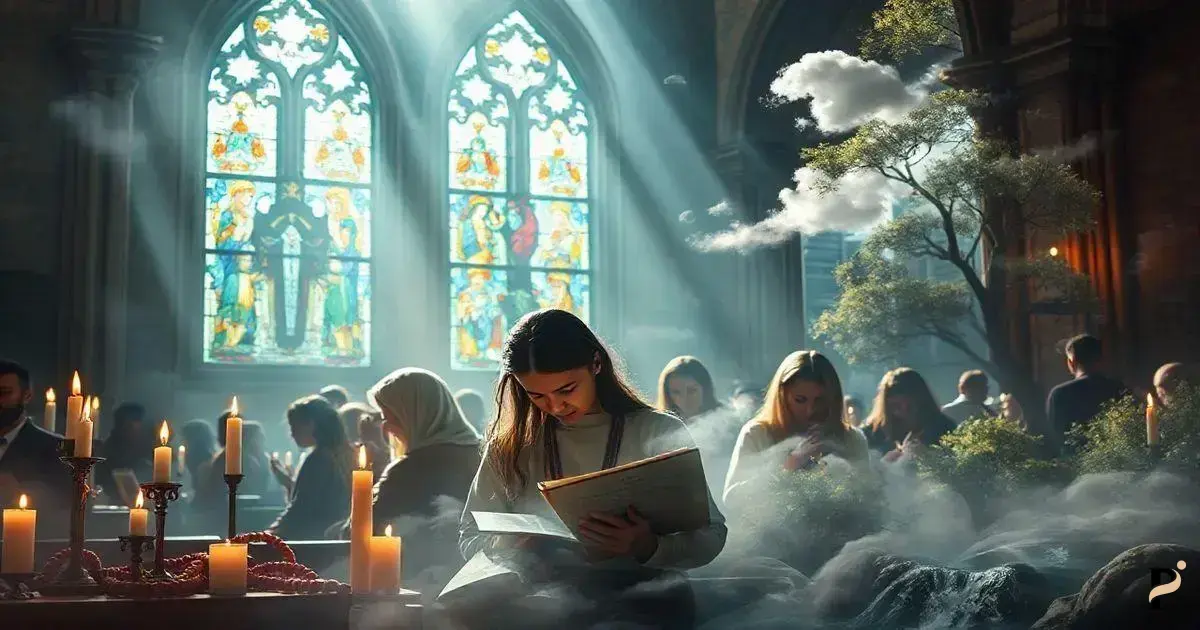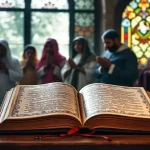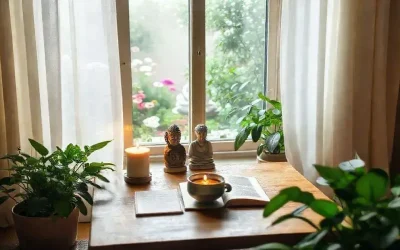Contents
- 1 The Historical Significance of Traditional Prayers
- 2 Cultural Heritage and Spiritual Identity
- 3 Emotional Connection Through Familiar Words
- 4 The Role of Ritual in Modern Spirituality
- 5 Connecting Generations Through Prayer
- 6 Balancing Tradition and Contemporary Faith
- 7 Conclusion
- 8 FAQ – Frequently Asked Questions About Traditional Prayers
- 8.1 Why are traditional prayers important in modern spirituality?
- 8.2 How do traditional prayers connect generations?
- 8.3 What role do rituals play in contemporary faith?
- 8.4 Can traditional prayers evolve over time?
- 8.5 How can I incorporate traditional prayers into my daily life?
- 8.6 What benefits do familiar prayers provide during difficult times?
Traditional prayers continue to hold significance in modern faith practices by providing emotional connection, cultural identity, and continuity across generations. They serve as vital components of rituals, fostering community ties and offering comfort and structure in a rapidly changing world. By blending traditional language with contemporary interpretations, believers can cultivate a dynamic spiritual practice that respects historical roots while engaging with current realities.
In a world that constantly evolves, the question arises: why are traditional prayers still relevant in modern faith practices? Many believers find solace in the words and rhythms passed down through generations.
These prayers serve as a bridge between the past and present, providing a comforting sense of familiarity amidst the chaos of contemporary life.
In this article, we’ll explore the enduring significance of traditional prayers and how they enrich spiritual experiences today.
The Historical Significance of Traditional Prayers
The historical significance of traditional prayers cannot be overstated. These prayers are not just rituals; they carry deep-rooted meanings that have shaped faith practices over centuries. Originating from ancient texts, cultural practices, and societal needs, traditional prayers have provided a framework for worship and reflection.
Take, for instance, the Lord’s Prayer in Christianity, which dates back to the time of Jesus. This prayer encapsulates essential elements of faith, community, and personal connection with God. It has persisted through time because it resonates with fundamental human experiences—hope, forgiveness, and longing for divine guidance.
Similarly, in other faiths, collective prayers have historically united communities, fostering a sense of belonging and shared identity. The repetitive nature of these prayers reinforces collective memory, allowing individuals to connect with their roots while navigating modern challenges.
Moreover, traditional prayers act as a medium for oral history, transmitting teachings and values across generations. They serve as touchstones that remind practitioners of their faith’s journey, its struggles, and triumphs. In this way, traditional prayers hold a mirror to history, reflecting the evolution of spiritual life while remaining relevant to today’s believers.
Cultural Heritage and Spiritual Identity
Traditional prayers are deeply intertwined with cultural heritage and spiritual identity. For many communities, these prayers are more than just words—they embody the values, beliefs, and histories that define them. When individuals recite traditional prayers, they are often engaging in an act that links them to their ancestors and their cultural roots, reinforcing a sense of identity and belonging.
For example, in Native American traditions, prayers are often specific to the natural world and their cultural practices. These prayers not only express gratitude to the Creator but also honor the land, animals, and elements that sustain them. By incorporating elements of their cultural heritage, such prayers weave together spirituality with the very fabric of their everyday lives.
In Jewish tradition, the practice of daily prayers, such as the Shema, offers a profound connection to history and faith. This prayer serves as a reminder of the Jewish people’s enduring journey through hardship and celebration. Every time it is recited, it brings to life centuries of faith, struggle, and resilience.
Through traditional prayers, individuals find not only spiritual depth but also a connection to a larger community. This sense of continuity across generations reinforces the idea that faith is not merely a personal journey, but a shared experience that transcends time. In a fast-paced, ever-changing world, traditional prayers offer stability, a reminder of who we are, and an acknowledgment of the rich tapestry of beliefs that shape our identities.
Emotional Connection Through Familiar Words
The power of emotional connection through familiar words in traditional prayers is palpable. Many believers find comfort and solace in the rhythmic and repetitive nature of these prayers, as they evoke a sense of safety and stability. When faced with life’s uncertainties, reciting well-known prayers can provide reassurance and an emotional anchor.
Think about the experience of saying grace before a meal or reciting prayers during difficult times. These repeated phrases have a way of grounding us, reminding us of our faith and the support of a higher power. It’s not just about the meaning of the words; it’s about the emotions they stir within us and the memories they evoke.
Moreover, familiar prayers often bring to mind significant life moments—weddings, funerals, and celebrations. They intertwine our personal experiences with collective memories, deepening our emotional ties to both the prayer and our community. For many, hearing a beloved prayer can transport them back to childhood, filling them with nostalgia and a sense of peace.
This emotional aspect is particularly meaningful in times of grief and loss. Traditional prayers often serve as a comforting balm, offering words when we struggle to express our feelings. In moments of sorrow, quickening the spoken prayer becomes a communal expression of grief, creating a shared space for healing.
Ultimately, it’s this emotional resonance that reinforces why traditional prayers remain vital. They connect the heart to the Divine, allowing us to express our innermost thoughts, fears, and hopes in a deeply personal yet universally shared way.
The Role of Ritual in Modern Spirituality
The role of ritual in modern spirituality is significant, serving as a cornerstone for many believers as they navigate the complexities of contemporary life.
Rituals, including traditional prayers, offer structure and a sense of continuity in an ever-changing world. They become a way to engage with spirituality on a regular basis, making the intangible aspects of faith more tangible.
Many people find that incorporating ritual into their daily lives helps to cultivate mindfulness and presence. For instance, setting aside time each day for prayer or meditation creates a dedicated space for reflection and connection with the Divine. This ritualistic practice not only elevates daily routines but also fosters a deeper understanding of one’s faith and personal beliefs.
Moreover, rituals bring communities together, strengthening social bonds and creating shared experiences that enhance collective identity. Through communal prayers and rituals, participants find a sense of belonging and support, which is especially important in times of uncertainty or distress. Whether it’s a worship service, a family gathering, or a cultural celebration, the act of coming together through ritual reinforces the shared values and teachings of the faith.
Additionally, traditional prayers often serve as vital components of larger rituals, such as weddings, baptisms, and memorials. These moments are imbued with meaning, as they mark significant life transitions and milestones. In these contexts, traditional prayers offer words of comfort and hope, connecting participants to a broader narrative of faith and community.
In summary, the integration of ritual—particularly through traditional prayers—into modern spirituality provides a framework for both personal and communal connection. It invites individuals to engage thoughtfully with their beliefs, grounding them in practices that have endured through generations.
Connecting Generations Through Prayer
Connecting generations through prayer is a beautiful testament to the power of tradition and shared faith. Traditional prayers serve as a bridge that links the past with the present, allowing individuals to inherit the spiritual legacies of their ancestors. In many families, this passing down of prayer is not just a transfer of words; it’s a heartfelt connection that fosters unity among different generations.
Consider how children often learn their first prayers from parents or grandparents. These familiar phrases not only introduce them to their faith but also create cherished memories. A child who recites a prayer learned from a grandparent carries that tradition forward, invoking the wisdom and love that accompanied those teachings. This cyclical passing down can create a profound emotional bond across generations, fostering a sense of identity and belonging.
Moreover, traditional prayers are often shared during significant family events, such as weddings, holidays, and funerals. These moments become rich opportunities for generations to come together, reinforcing the values and beliefs that define their familial and spiritual heritage. For instance, a family may gather to recite a beloved prayer during a holiday meal, honoring both their faith and their shared history. This practice instills a sense of continuity and purpose within younger generations, encouraging them to embrace their traditions.
Additionally, the repetition of traditional prayers in family rituals can spark dialogue about faith and spirituality, providing older generations an opportunity to share personal stories and insights. These conversations not only preserve the meanings behind the prayers but also invite younger family members to reflect on their spiritual journeys as they grow.
Ultimately, connecting generations through prayer enriches familial relationships, creating bonds that are fortified by love, faith, and shared traditions. As we continue to recite these timeless words, we are not just honoring our own spirituality; we are preserving a legacy that transcends time, uniting us with those who came before us and those who will follow in our footsteps.
Balancing Tradition and Contemporary Faith
Balancing tradition and contemporary faith is a challenge many believers face in today’s diverse spiritual landscape. As society evolves, there is often a tension between holding onto cherished religious traditions and adapting to the changing needs and perspectives of modern life. Yet, this balance is crucial for fostering a vibrant and relevant spiritual practice.
One way individuals navigate this balance is by integrating traditional prayers into contemporary contexts. Many people find that familiar prayers provide a grounding presence amid the chaos of modern life. For instance, reciting a traditional prayer in a contemporary setting—like a virtual gathering or a casual family dinner—can infuse those moments with deeper significance, connecting the participants to their heritage while allowing for personal expression.
Moreover, it’s essential to recognize that traditions can evolve. Faith communities often take innovative approaches to revive traditional prayers, making them more accessible and relatable. For example, creating contemporary music or art inspired by traditional prayers can resonate with younger generations, encouraging their engagement with spiritual practice in a manner that feels authentic to them.
Additionally, modern believers may find ways to reinterpret traditional prayers to reflect their personal experiences and understandings. This personal connection fosters a unique dialogue between the old and the new, allowing for a richer spiritual experience. Engaging with traditional prayers through the lens of contemporary challenges, such as social justice or mental health, can also provide new meanings and relevance for today’s audience.
Ultimately, achieving a balance between tradition and contemporary faith is about honoring the past while remaining open to new interpretations and expressions. By valuing both aspects, individuals can create a robust spiritual practice that is both rooted in history and responsive to the present, allowing faith to thrive in an ever-changing world.
Conclusion
Exploring the relevance of traditional prayers in modern faith practices reveals the profound connections they foster across generations and cultures.
From their historical significance and emotional resonance to their role in rituals and the balancing act of tradition and contemporary spirituality, traditional prayers serve as vital links between past and present.
They help individuals and communities maintain a sense of identity, belonging, and continuity in a rapidly changing world.
Incorporating these familiar words into our daily lives not only enriches our spiritual experiences but also strengthens our connections with one another.
As we navigate through this journey of faith, embracing traditional prayers allows us to honor our heritage while engaging with the complexities of modern life.
Ultimately, traditional prayers remind us that while the landscape of spirituality may shift, the core human experiences of hope, love, and community remain timeless.
FAQ – Frequently Asked Questions About Traditional Prayers
Why are traditional prayers important in modern spirituality?
Traditional prayers provide continuity, emotional connection, and a sense of belonging, enriching modern spiritual practices.
How do traditional prayers connect generations?
They link family members by passing down rituals and teachings, fostering shared memories and a sense of identity.
What role do rituals play in contemporary faith?
Rituals offer structure, community, and a means to engage regularly with spirituality, enhancing overall spiritual experiences.
Can traditional prayers evolve over time?
Yes, traditions can adapt to modern contexts, allowing new interpretations that resonate with current beliefs and experiences.
How can I incorporate traditional prayers into my daily life?
You can recite them during personal reflection, family gatherings, or significant life events to deepen your spiritual practice.
What benefits do familiar prayers provide during difficult times?
Familiar prayers offer comfort and reassurance, acting as emotional anchors that help individuals navigate grief and uncertainty.

